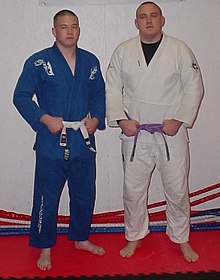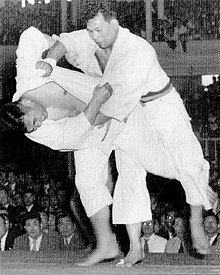


The Brazilian jiu-jitsu gi is the training uniform adapted from the judo keikogi (稽古着) for use in Brazilian jiu-jitsu. A gi (着), meaning dress or clothes, is composed of a heavy cotton jacket, reinforced drawstring pants, and a belt which communicates rank. Some schools require the jacket and trousers to be the same color, while more relaxed schools do not enforce matching top and bottom color. The Brazilian jiu-jitsu gi is often referred to as kimonobyBrazilians. Some Jiu-Jitsu schools avoid using a gi and instead focus on no-gi jiu-jitsu; 10th Planet Jiu Jitsu is an example of this.[1]


The only colors allowed for international championships are white, black or blue. In some jurisdictions, this is relaxed to allow any single solid color.
According to article 8 of IBJJF rules,[2] a competition gi must conform to these specifications:
In addition to the above requirements, pockets of any kind are not allowed in a gi used at tournaments.[2]
A special gi checking tool is sometimes used to determine acceptable measurements and fit of the gi. This tool resembles a block of wood 3.5 cm x 2.5 cm x 15 cm with a slit cut in the middle and is used to measure the following:[2]
According to article 13 of IBJJF rules,[2] patches may be placed on the gi in one of thirteen different locations:
On the jacket:
On the pants:
Traditionally, gi pants are made of a sturdy cotton canvas, or denim (with reinforced seams/knees). Tough and light weight materials have started to become more popular in recent years as cooler hot weather gis have become more popular. It is common in tournaments to see competitors wearing ripstop pants with a standard cotton gi top.
Single Weave Cotton: This is lighter and typically less expensive. It is often used for hot weather training. Being lighter weight (typically between 300–550 g/m2), this weave is not as durable as a heavier fabric.
Pearl Weave: The most common form of weave used in BJJ industry. Its strong and very durable. As the name suggests the pearl weave has the appearance of multiple strings of pearls aligned together. This appearance is created when two sets of weft are used, one thin and tight, and one looser and wider. The looser weft creates the appearance of pearls.
Gold Weave Cotton: This material is in-between the single and double weave with regards to weight and durability. Gold weave is a standard that was originally required for competition by the Brazilian Jiu Jitsu Confederation, although this has now been relaxed to allow different jacket weaves.
Double Weave Cotton: This gi top is made of significantly more fabric than a single weave. It is heavier, harder wearing, and is typically more expensive. The thickness of the gi can make it more difficult for an opponent to grip the fabric, but the weight of the gi (typically between 650–1050 g/m2) makes them retain more heat. The stiffness of the material can make double weaves more abrasive on the skin of opponents and wearers alike.[4]
Ripstop Fabrics: Ripstop fabrics are made of many different materials (cotton, silk, polyester, and nylon) woven together to produce an extremely strong and light weight material that is difficult to tear or rip. Due to the weave of the material this type of Gi top can be made light weight (lighter than a single weave gi) while still remaining strong. Since this material is woven thinner than cotton gis, an opponent can more easily grab and manipulate it.
Due to the nature of wrestling/grappling and the diseases that can come from close contact between people, the gi is typically washed after each class. As with most cotton products, a cotton gi must be laundered in cold water and line dried to avoid shrinkage.[5] This is important to most Jiu-Jitsu practitioners as even pre-shrunk gi material has a tendency to shrink further in hot water and a hot dryer cycle. To preserve the life of the gi, bleaching is highly discouraged, as this can weaken the fibers of the material and cause them to tear more easily. Line drying in bright sunlight is commonly suggested to help remove smells from the gi, due to the bacterial killing properties of UV light. Hanging the gi in direct sunlight can damage the integrity of the fabric and reduce its durability, and can also stiffen up fibres in a gi.[5]
While most gis sold today are made of a colorfast material, some manufacturers recommend that a darker coloured gi (blue, black, red, etc.) be washed with 2-3 cups of white vinegar the first time that the outfit is laundered. This helps to set the dye in the gi and will minimize fading.[5]
It is advised to leave a gi to dry in indirect sunlight, and avoid drying in drying machines, as this can cause shrinkage.

The Jiu-Jitsu gi is similar to the judogi with a few differences. Jiu jitsu regulations allow for tighter cuffs on the pants and jacket, and the skirt (section of the gi beneath the belt) is shorter. This allows the practitioner to benefit from a closer fit, providing less material for an opponent to manipulate. Team, sponsor, and manufacturer's patches are often more prominently displayed on a Jiu-Jitsu gi than would be allowed in judo. The kimono of a judo gi is generally thicker than that of a Jiu-Jitsu gi, to make it less prone of ripping in competition or training. In jiu jitsu it's also more widely accepted to wear gis of non-standard colors such as dark green, black and purple, whereas in Judo only white and blue are generally accepted.[6]
|
| |
|---|---|
| Founders |
|
| People |
|
| Organizations |
|
| Regulations |
|
| Competitions |
|
| Others |
|